Dairy contracts in European countries: research
Analysis on the current state of the dairy sector and supply chains within European countries and the application and impact of mandatory written contracts and their suitability and potential application in Scotland.
7. Annexes
7.1 Overview of the studied dairy industries
7.1.1 France
Production
7.1 France’s production accounts 25 billion tonnes, which is equivalent to 15.8% of EU milk deliveries (based on 2017 volumes). Its exports of dairy products, converted into milk equivalent represent the 41.6% of the milk deliveries, and 13.0% of EU dairy exports in milk equivalent (year 2017) (CLAL, 2019). A summary of statistics for the dairy sector in France is presented in Table A.1 in the Annex, section 7.2.
7.2 France is the seventh biggest world producer of milk after the United States, India, China, Brasil, Russian and Germany and the second in Europe (FranceAgriMer 2018a). The French dairy productios is distributed among twelve regions or departments (S.S.P. Enquête Annuelle Laitière – 2017). However, 55% of farms and milk production are concentrated in the North-West of France in three regions namely: Bretagne, Pays-de-la-Loire and Normandie. The Bretagne department is the most important, accounting for almost 27% of the farms and 20% of milk production. Pays-de-la-Loire and Normandie covers respectively 16% of the French milk production and hosts 14% of farms.
7.3 Three main production areas can be distinguished in France (Dervillé and Allaire, 2014): specialised plain areas generally located in the north-western part of France, mixed farming areas with light milk density, and mountainous areas. As stated by Trouvé et al. (2016), the French farm structure and its spatial distribution was highly influenced by the implementation of quotas. The abolition of quotas in 2015 caused a change in its dynamics of growth with the west, north and east plain areas seeing growth. Mountain farms experienced declining profitability while there was an abandonment of farmland in the intermediary areas.
7.4 The Dairy production sector in France has gone through a dramatic structural change during the period 2007-2017, which was characterised by a reduction of 63 thousand dairy farms and around 100 thousand cows (CNIEL, 2018).
Processing
7.5 At a dairy processing level, the percentages of milk used for domestic liquid consumption and manufacture are: 40% of the milk is processed into cheese (15% of the total cheeses are those under Protected Denomination of Origin (PDO)), 27% into butter and cream, 13% into milk powder, 10% into milk, 7% into fresh products (yogurts or deserts) and 3% is directed to other uses. In addition, approximately 25% of the processed products are sold to industries for further processing whilst the 75% are sold to the general public (FranceAgriMer 2018a).
7.6 There are more than 730 dairy processors in France[9] (CNIEL, 2018) with a turnover of 19,711 million euros (CNIEL, 2018).
7.7 624 processors reported manufacturing cow milk to a monthly dairy survey during 2017 (FranceAgriMer, 2018b). Of these, cooperatives groups represent 50.4% of all the processors and the remaining 49.6% are private operators. The majority of these establishments (58.7%) are specialised on only one dairy category such as packaged milk, fats, packaged cream, ultra-fresh products - yogurts and dessert, cheeses or milk powders. Cheese processors are the most significant most significant group (70.5% of the processors) followed by ultra-fresh products (14.5%) and milk powder (8.2%) (FranceAgriMer, 2018b).
7.8 There are different size of coperatives: 10 very large ones with a turnover in excess of 300 million euros, 30 medium size cooperatives and 200 fruitières with a turnover much lower (Trouvé et al., 2016). As of 2011, Sodiaal is the largest French cooperative group, ranking 17th in the world, 4.9 billion litres collected. Other large purchasers areLaïta, Agrial and Eurial collecting together around a billion litres of milk.
7.9 Among the large private companies, four are in the top 25 world turnover ranking: Lactalis (No. 1, with 16 billion Euros in turnover), Danone (No. 4), Bongrain/Savencia (No. 18) and Bel (No. 24) (CNIEL, 2018). The distribution of manufactured products among the different dairy products areas does not vary between cooperatives and private groups (FranceAgriMer, 2018b).
7.10 French dairy processors are concentrated in six regions: 72% of the production is located in four regions, being Auvergne-Rhône-Alpes the most important one as concerning the number of manufacturing sites. However, when considering the volume of milk processed Hauts-de-France is the leading region covering 25% of the produced volume followed by Bretagne and Auvergne-Rhône-Alpes with 17.5% and 15.6% respectively (FranceAgriMer, 2018b). The degree of concentration per dairy products area changes by products; nevertheless the top processors are: Lactalis, Danone, Savencia, Sodiaal (FranceAgriMer, 2018b).
7.1.2 Hungary
7.11 In 2017 Hungary, which a production of 1.9 billion tonnes of milk, accounted for 1.0% of EU milk deliveries. Its exports of dairy products converted into milk equivalent were 40.4% of the milk deliveries and 0.8% of EU dairy exports (CLAL, 2019). A summary of statistics for the dairy sector in Hungary is presented in Table A.2 in the Annex, section 7.2.
7.12 The Hungarian dairy sector underwent significant structural transformation during the last two decades because of two key political factors: (1) the fall of the socialist system in 1989 and (2) its accession to the European Union (EU) in 2004 (Perekhozhuk, et al., 2011).
7.13 One of the results of the liberalisation of the economy was the reduction in the number of dairy farms (Bakucs, et al., 2013). Between 2000 and 2016, the number of dairy cows decreased by 31.2% from 355 to 244 thousand heads. Raw milk production fell by only 8% however as milk yieldsgrew steadily during the period. By 2016, they had risen to 7,862 kg/head from just over 6,000kg/head in (European Commission, 2019).
7.14 The abolition of the Hungarian national milk price support system, incompatible with EU competition rules, has been pointed out as another underpinning factor for this decline in the sector. Until 2004, the Hungarian government favoured those dairy processors who paid a targeted minimum farm gate price to producers with an export subsidy. This resulted in producers getting an artificially high raw milk price in comparison with neighbouring countries such as Poland, the Czech Republic and Slovakia (Hockmann and Vöneki, 2009). This situation ended with the elimination of the export subsidies.
7.15 One of the main characteristics featured by the Hungarian dairy sector since its accession to the EU has been its low competitiveness with respect to other EU members. This low competitiveness is due to several factors, which Szücs and Szöllösi (2015) have summarised in three main groups: (1) factors underpinning the low profitability of milk production settings, with high average costs of production; (2) the unfavourable market position of the Hungarian processing industry, mainly focused on low value added products with high average costs of production facing an internal low demand market for dairy products and accompanied by increasing quality regulatory requirements; (3) factors that have favoured the introduction of products from other EU members to cover dairy internal market gap.
7.1.3 Italy
Production
7.16 Italy accounted for 8.2% of EU milk deliveries in 2017, i.e., 12 billion tonnes of milk. The same year its exports of dairy products, converted into milk equivalent (ME) represented 32.4% of the milk deliveries and 4.7% of EU dairy exports in ME (CLAL, 2019). A summary of statistics for the dairy sector in Italy is presented in Table A.3 in the Annex, section 7.2.
7.17 Approximately 12 millions of tonnes of milk are produced in Italy (2017) and about 13 millions of tonnes of milk are converted in a million tonnes of cheese (more than 440 thousand tonnes are Protected Designation of Origin (PDO) cheeses - 37 Italian cheese carry a PDO label), almost three millions of tonnes of pasteurised drinking milk and 190 thousand tonnes of yogurts and fermented milks. The difference between the domestic milk production and the utilisation is explained by imports from mainly France and Germany.
7.18 The Italian production of cow’s milk is essentially concentrated in 8 regions: Lombardy, Emilia Romagna, Veneto, Piedmont, Trentino Alto Adige, Lazio, Puglia and Friuli Venezia Giulia. In particular, 41% of the total production comes from the Lombardy region, while the first 4 regions (Lombardy, Emilia Romagna, Veneto and Piedmont) represent about 75% of the total production.
Processing
7.19 In total, about 34 thousand processing companies operate in Italy, of which about 15 thousand are in the plain areas, 16 thousand in mountain areas and 3 thousand in other disadvantaged areas. Production of mountain and disadvantaged areas, however, represent only 20% of the total production, in contrast with the 80% from the plain areas.
7.20 The distribution of the number of companies by size classes clearly shows how about 2/3 of the companies are located in the two smaller size classes (with a production of less than 200 tonnes of milk) and accounting for less than 15% of total production. Large companies (with a production of over 1,000 tonnes of milk) instead account for less than 1/5 of the total and represent over 70% of total production.
7.21 Although still characterised by a strong productive fragmentation, the sector has in the last two decades been subject to a particularly intense restructuring phase which led to the drastic reduction in the number of companies as well as the increase in their size and productivity.
7.22 The reduction in the number of companies affected particularly small companies and has been more pronounced in the plain area, increasing the productivity gap between the plain and mountain areas. Average production per company in plain areas increased from 174 to 579 tonnes of milk processed in the last two decades whilst in mountain areas it went from 40 to 113 tonnes.
7.23 At the regional level the structural differences are also marked. Regions such as Lombardy, Emilia Romagna and Veneto have levels of milk production per company higher than the European average (comparable to those of France and Germany), while regions such as Puglia and Trentino Alto Adige present a lower average company size.
7.24 About 70% of the milk produced in Italy is destined to the production of a great variety of traditional cheeses, all of them unique in their organoleptic and nutritional characteristics and processing technique: Mozzarella occupies the first place as far as volume is concerned – 250,000 tonnes/year – followed by the two most popular PDO cheeses in the world: Grana Padano – the most exported with 163,000 tonnes/year and Parmigiano Reggiano – the most imitated with 116,000 tons/year. Other cheeses are Gorgonzola, Pecorino, Asiago, Taleggio.
7.25 Italy exports almost 250 thousand tonnes of cheese, with a value of €1.4 billion. Main Italian exported cheeses are Mozzarella and other fresh cheeses (36.4%), Grana Padano PDO and Parmigiano Reggiano PDO (25%) followed by Pecorino Romano PDO, Gorgonzola PDO and Provolone.
7.1.4 Poland
Production
7.26 Poland milk production in 2017 was 13.6 billion tonnes, i.e., represents 7.5% of EU milk deliveries, with its exports of dairy products, converted into milk equivalent (ME) being 33.7% of the milk deliveries, and 5.0% of EU dairy exports (CLAL, 2019). A summary of statistics for the dairy sector in Poland is presented in Table A.4 in the Annex, section 7.2.
7.27 In 2013 had Poland around 150 thousand dairy farms with a size of more than 10 ha (from a total of 335 thousand farms). Additionally, approximately 82% are farmers’ owned. Information to 2015 indicated that Poland has 132.5 thousand commercial dairy farms.
7.28 As regards the regional distribution of the production, Podlaskie, in the north-east of Poland, is by far the largest region by the number of dairy cows (18.3% of the total). It is followed by Wielkopolskie (12% of the total). Both regions (Wielkopolskie and Podlaskie) gained importance following the market-driven transition in 1989 and accession to the EU in 2004. The elimination of the dairy quota system in the EU in 2015 offered new expansion opportunities (Sobczyński et al., 2015).
7.29 Poland dairy sector relays significantly on the external market since 25% of its national production (by volume) is sold outside the country, being 77% sold in the European Union and 10% in the Central European Initiative. Russia was a very important market for its cheeses, and the Russian embargo affected significantly Polish exports. It should be noted, however, that since 2009 the volume of Polish exports has not increased. The increase in value has been due to the evolution of international prices, the favourable exchange rate, and an increase in exports of products with higher added value, such as cheeses (Trouvé et al., 2016; Martinez, 2013).
Processing
7.30 In Poland there are approximately 165 dairy processing plants of which many are independent companies or small cooperatives. There are 10 large processors covering about 60% of domestic production and the rest are of relatively small in size (Trouvé et al., 2016). The most important dairy firm in the Poland is ranked in 42nd place in terms of turnover at the European Union level. In fact, about 75% of the milk processed is in cooperatives and the rest is private firms.
7.31 Poland is the 4th European producer of milk but 6th when considering dairy processing, with 10 million tonnes of raw milk processed every year in Polish territory. Note that part of the Polish milk production is exported to be processed in neighbouring countries such as Germany. Nevertheless, Poland is the 7th largest cheese producer in the world, and the 5th in the European Union.
7.32 According to Trouvé et al. (2016) most the cooperatives have a highly politicised management board, strongly linked to the PSL1 (Polskie Stronnictwo Ludowe, the Polish Peasant Party), a member of the ruling coalition, and thus have an important power over the Ministry of Agriculture.
7.33 Since 2015, foreign companies such as Danone, Lactalis, Bongrain and Hochland, have been well established in Poland and they transform about 25% of the milk collection (Trouvé et al., 2016). It should be noted that the total number of dairy processing plants is decreasing at a slow rate, while the turnover has been increasing rapidly from 2016 to 2017. This indicates a very slow concentration of the processing sector. The dairy processing plants employ more than 32 thousand people. The number of dairy processing plants has been stable whilst the number of employees per plant is growing slowly.
7.1.5 Romania
Production
7.34 The Romanian production of milk in 2017 was 3.8 billion tonnes and accounted for 0.7% of EU milk deliveries in 2017. Its exports of dairy products, converted into milk equivalent (ME) represented 22.2% of the milk deliveries and 0.3% of EU dairy exports (CLAL, 2019). A summary of statistics for the dairy sector in Romania is presented in Table A.5 in the Annex, section 7.2.
7.35 The Romanian dairy production sector is extremely fragmented, small sized farms are prevalent on the sector. According to data from the Romania Ministry of Agriculture, Forestry and Rural Development, by April 2009 there were around 850 thousand dairy producers, of which 89% held one or two cows, amounting for more than 60% of the total dairy livestock (Pieniadz, et al., 2009). As to 2017, Romania still had the lowest average number of cows per holding (3), the lowest level of milk production per holding (10 tonnes), and the lowest annual yield per cow (3.4 tonnes) of the 28 European Union members (Wijnands, et al., 2017).
7.36 Measured in terms of economic output, more than 81% of dairy farms presented in 2013 a level of EU standard output value below 7,999 euros per holding (Grodea, 2016). In addition, Romania presents one of the highest levels of employment in agriculture within the European Union. However, this vast farm labour force possesses a poor level of training with a high percentage of farm holders above 64 years of age (Fredriksson, et al., 2017). Such features delineate the traditional structure of a very fragmented and low productive sector.
7.37 Although the production settings have begun to change and evolve towards fewer and larger production units., and the milk collection method is also changing increasingly evolving towards direct deliveries to dairies and moving away from the traditional indirect method that used communal collecting points. However, there still exist important differences among different regions (Pieniadz, et al., 2009).
Processing
7.38 The above described production sector faces a dairy processing industry where big processors (those who employ more than 250 employees) generated more than 60% of the total dairy industry turnover in 2013. The proportion between these big processors and the number dairy Romanian producers was 1 processor per more than 7,000 producers. Meanwhile as to 2017, there was not any Romanian dairy processing cooperative operating in the country, in other words all Romanian cow milk production was delivered under a contractual agreement to private dairy processors (Wijnands, et al., 2017).
7.39 Understandably, looking at this fragmentation on production, small size of production settings, and lack of cooperative initiatives among producers, the latest European Commission report on the operation of the Milk Package provisions reflects that representatives of the Romanian dairy sector perceived a clear potential for more producer organisations (PO’s) in their territory (European Commission, 2016). Currently, only two PO’s are in operation in Romania (Wijnands, et al., 2017).
7.1.6 Spain
Production
7.40 Spain accounted for 4.5% of EU milk deliveries in 2017 with a production of 7.2 billion tonnes. Its exports of dairy products converted into milk equivalent (ME) represented 21.9% of the milk deliveries and 2% of EU dairy exports (CLAL, 2019). A summary of statistics for the dairy sector in Spain is presented in Table A.6 in the Annex, section 7.2.
7.41 The Spanish total milk production was slightly above 7 million tonnes in 2017, increasing 1.8% from the previous year.
7.42 The production is located mainly in the northern area of Spain (81%), with a high concentration on the NorthWest regions of Galicia (38%) Asturias (8%), and Cantabria (6%). Likewise, the number producers is eminently concentrated in those regions congregating 78% of Spain’s milk producers.
Processing
7.43 The Spanish processing industry generated €8,640 millions of output value in 2015, that accounted for 1.8% of the total Spanish industrial production and 9.2% of the food and drink sector. The industrial sector comprissed 1,557 dairy business in 2015. Although, the ten biggest processing groups account for 68% of the total output value.
7.2 Dairy statistics by country
Table A.1: UK - Summary statistics for the dairy sector
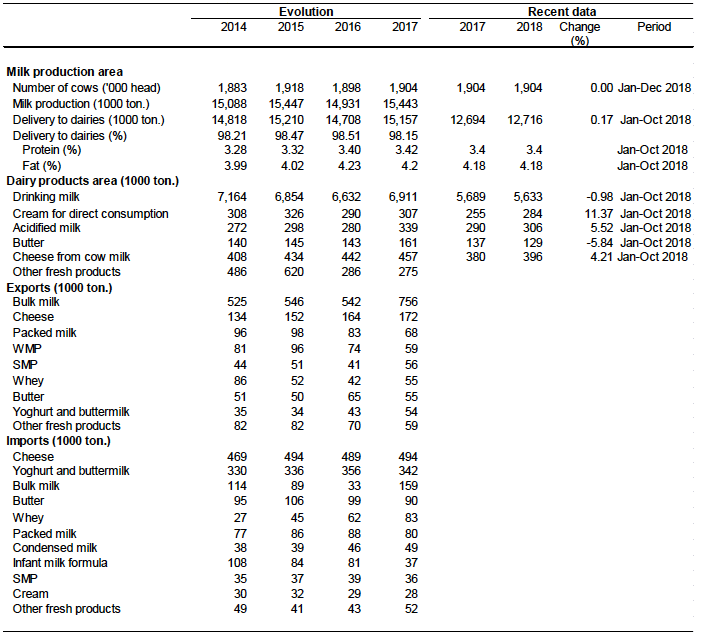
Source: CLAL
Figure A.1.1: UK – Milk deliveries and dairy exports in milk equivalent.
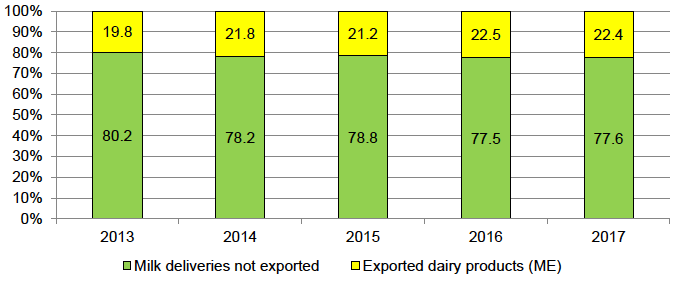
Source: CLAL
Figure A.1.2: UK – Farm milk price/EU average farm milk price 2007-18
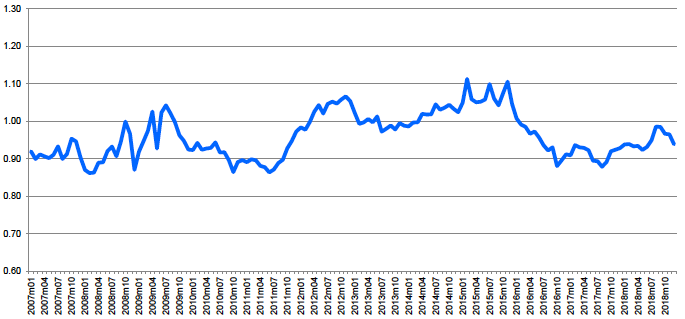
Source: European Commission
Note: Prices not adjusted by quality factors (i.e., fat and protein content as well as bacterial content).
Table A.2: France - Summary statistics for the dairy sector
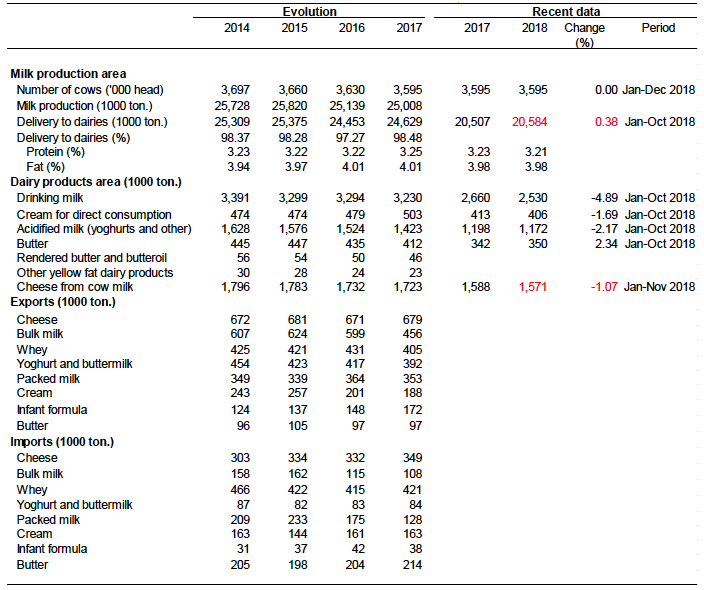
Source: CLAL
Note: Figures in red indicate estimates.
Figure A.2.1: France – Milk deliveries and dairy exports in milk equivalent.
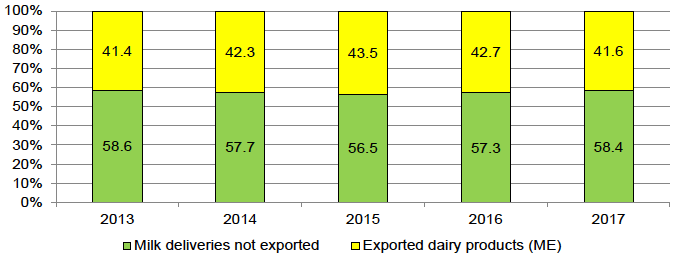
Source: CLAL.
Figure A.2.2: France – Ratio farm milk price/EU average farm milk price 2007-18
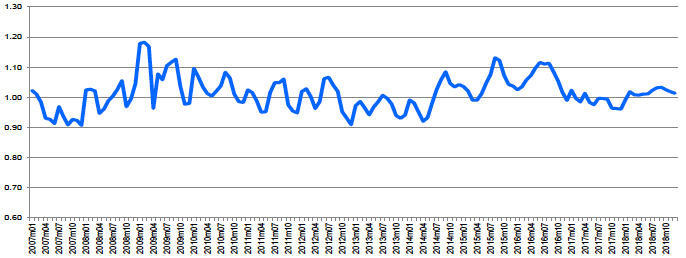
Source: European Commission.
Note: Prices not adjusted by quality factors (i.e., fat and protein content as well as bacterial content).
Table A.3: Hungary - Summary statistics for the dairy sector
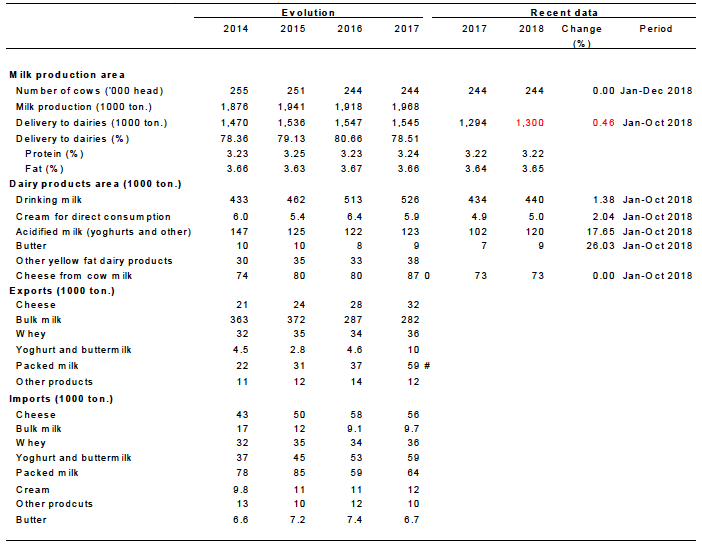
Source: CLAL
Note: Figures in red indicate estimates.
Figure A.3.1: Hungary – Milk deliveries and dairy exports in milk equivalent.
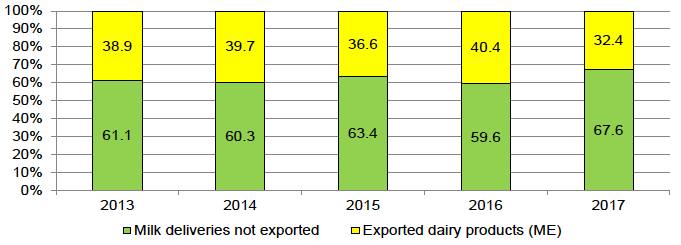
Source: CLAL
Figure A.3.2: Hungary – Farm milk price/EU average farm milk price 2007-18
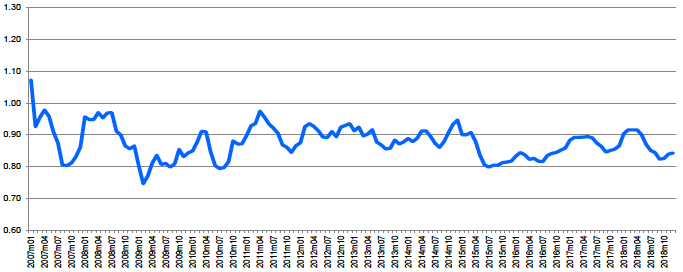
Source: European Commission
Note: Prices not adjusted by quality factors (i.e., fat and protein content as well as bacterial content).
Table A.4: Italy - Summary statistics for the dairy sector
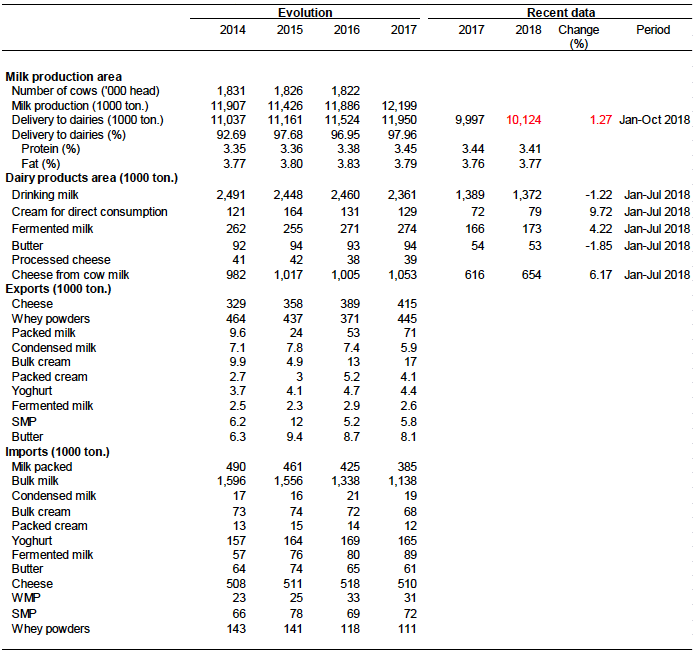
Source: CLAL
Note: Figures in red indicate estimates.
Figure A.4.1: Italy – Milk deliveries and dairy exports in milk equivalent.
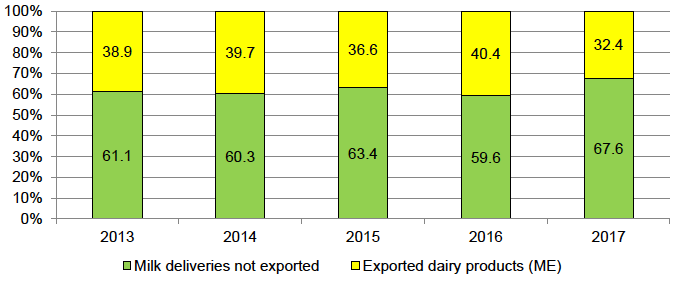
Source: CLAL
Figure A.4.2: Italy – Farm milk price/EU average farm milk price 2007-18
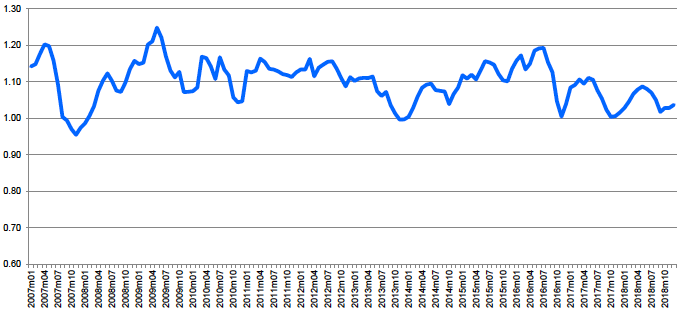
Source: European Commission
Note: Prices not adjusted by quality factors (i.e., fat and protein content as well as bacterial content).
Table A.5: Poland - Summary statistics for the dairy sector
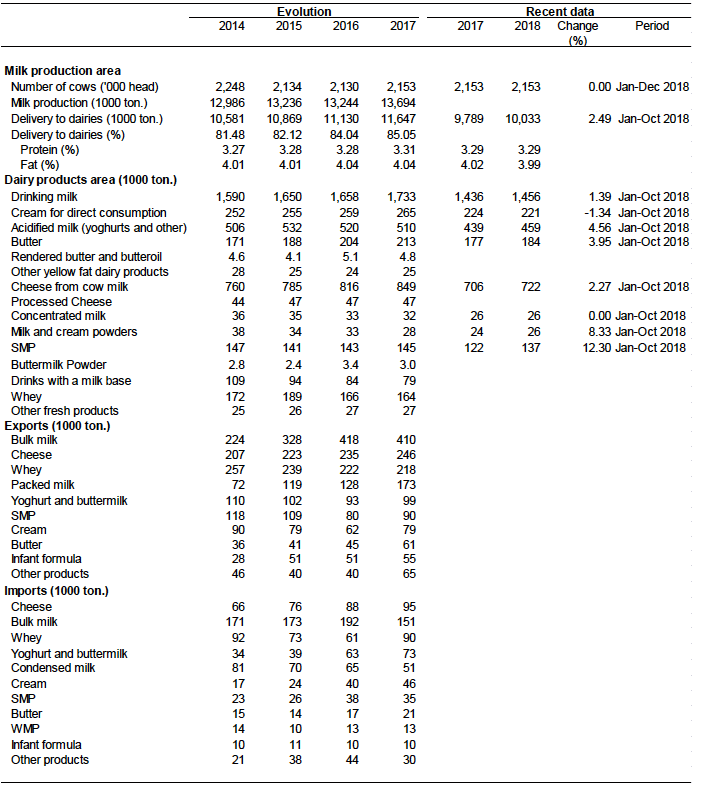
Source: CLAL
Figure A.5.1: Poland – Milk deliveries and dairy exports in milk equivalent.
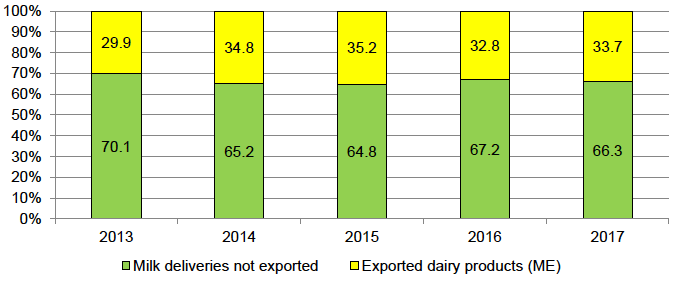
Source: CLAL
Figure A.5.1: Poland – Farm milk price/EU average farm milk price 2007-18
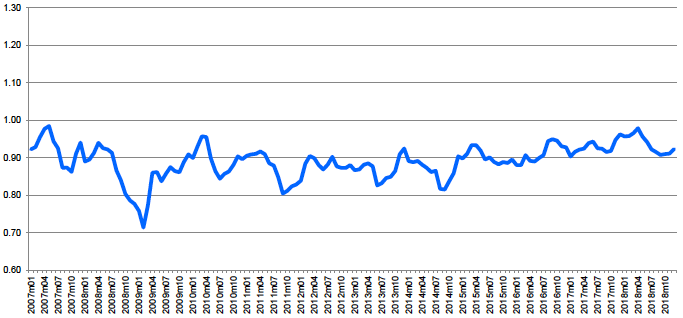
Source: European Commission
Note: Prices not adjusted by quality factors (i.e., fat and protein content as well as bacterial content).
Table A.6: Romania - Summary statistics for the dairy sector
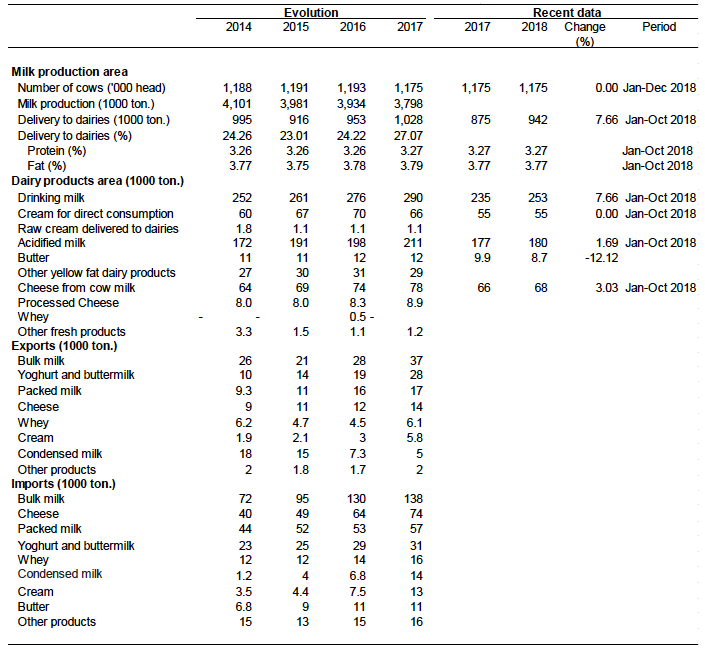
Source: CLAL
Figure A.6.1: Romania – Milk deliveries and dairy exports in milk equivalent.
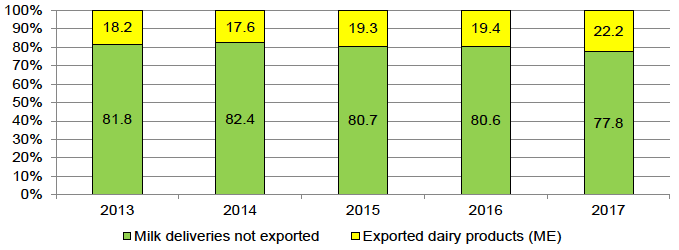
Source: CLAL
Figure A.6.2: Romania – Farm milk price/EU average farm milk price 2007-18
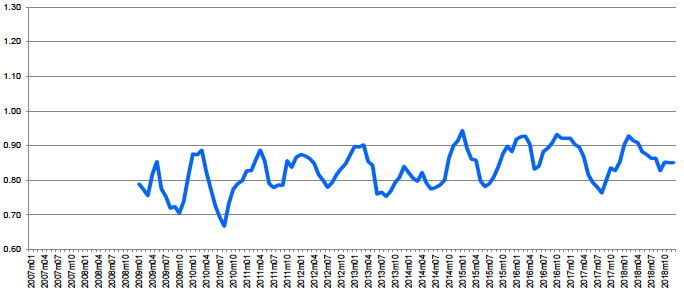
Source: European Commission.
Note: Prices not adjusted by quality factors (i.e., fat and protein content as well as bacterial content).
Table A.7: Spain - Summary statistics for the dairy sector
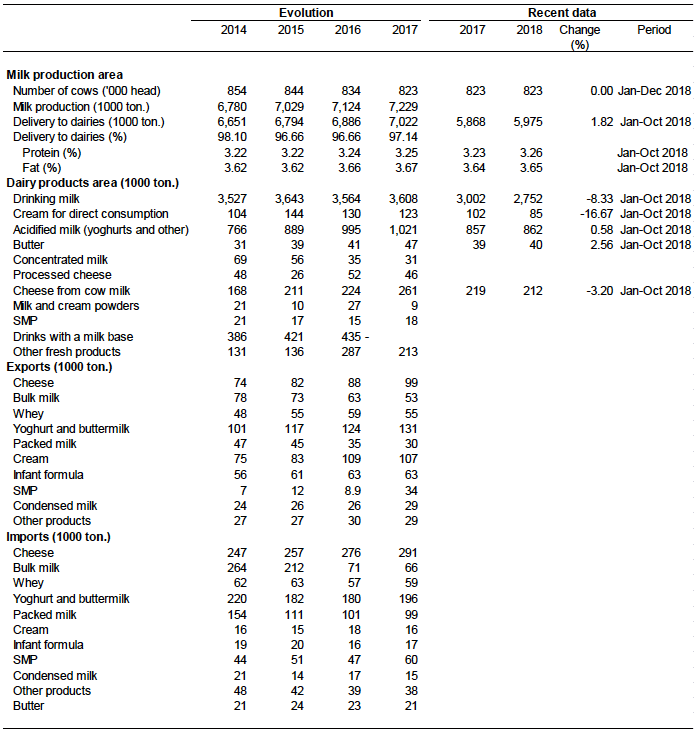
Source: CLAL
Figure A.7.1: Spain – Milk deliveries and dairy exports in milk equivalent.
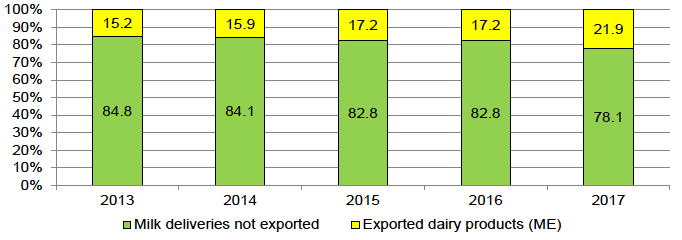
Source: CLAL
Figure A.7.2: Spain – Farm milk price/EU average farm milk price 2007-18
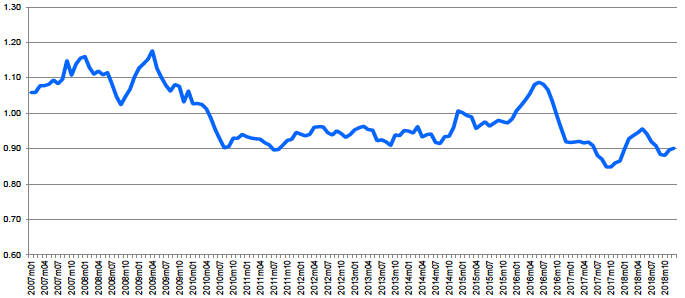
Source: European Commission
Note: Prices not adjusted by quality factors (i.e., fat and protein content as well as bacterial content).
7.3 Mandatory contracts and farm price volatility (full analysis)[10]
Abstract
This study investigates the impact of the implementation of mandatory written contracts (MWC) under the EU agricultural Common Market Organisation (CMO) regulation in raw milk price volatility among twelve member states using GARCH models. The results indicate that at least in three of the countries where MWC have been implemented (France, Hungary, and Slovakia) raw milk price volatility has decreased after its introduction. These findings are consistent with some of the aims of the 2012 Milk Package to improve negotiating practices and transparency in the supply chain.
Keywords: Dairy, Mandatory Written Contracts, Agricultural policy, Volatility, GARCH model.
JEL code: Agricultural Markets and Marketing; Cooperatives; Agribusiness - Q130; Agricultural Policy, Food Policy – Q180
Introduction
7.44 The 2018 UK government’s review for extending the remit of Groceries Code Adjudicator’s (GCA) to primary suppliers, determined that the UK agricultural sector suffered from important issues such as: (1) unbalanced bargaining power between producers and processors, (2) unfair or unclear contract terms extensively used throughout the supply chain, (3) late payments, and (4) diminished trust levels among stakeholders due to lack of transparency (UK Government, 2018). Raw milk is currently marketed in accordance with the Dairy Industry Code of Best Practice on Contractual Relationships (the Code) that was agreed in July 2012 between Dairy UK (the main association of UK processors), the National Farmers Union (NFU), and the NFU Scotland. This set of rules of voluntary adoption for the parties focuses mostly on the specification of the price.
7.45 The Code states that milk price may be set by several means: (1) specifying a fixed price, (2) establishing a price notification system, or (3) any other pricing mechanism (NFU, 2012). The aims of the Code were commendable although its effectiveness has been limited, and dairy farmers have complained about the discretionary ability of processors to change the price giving only a 30-day notice and transferring in this way the market risks to producers, whilst establishing notice periods of up to 12 months for the farmer to terminate a contract. In spite of the broad engagement in this voluntary Code throughout the chain, as the conclusions of the consultation on the extension of the remit of the GCA made clear, its use has not been enough to solve the formerly stated issues within the sector. As a result, the UK Government has announced plans to introduce mandatory written contracts (MWCs) in the UK dairy sector. MWCs were introduced in EU legislation in 2012 with the aim of improving contractual negotiation in the Supply chain. The UK government has referred explicitly to this regulation when announced its plans for introducing MWCs in the UK. In order to adequately inform the necessary secondary legislation to do that, the UK Government announced in February 2018 the call for a formal consultation process by March the same year (UK Government, 2018). This call has come to a standstill due to the Brexit process.
7.46 MWCs have been implemented in some member states, but to our knowledge there is no evidence about their impact on milk price volatility. This study uses the Generalised Autoregressive Conditional Heteroscedasticity (GARCH) model to evaluate whether milk price volatility has changed after the implementation of MWCs in twelve EU member states, using monthly data on farmgate milk prices sourced from the European Milk Market Observatory.
7.47 The structure of the paper is organised as follows. First, the European Union agricultural regulation as to the MWCs and its level of implementation are briefly reviewed. Second, the empirical methodology used in this study is explained, with some references about the concept of volatility and the data utilised are shown. Third, the findings are presented and discussed. Finally, some remarks are offered to conclude.
The Milk Package
7.48 The price crisis that occurred within agricultural commodity markets in the period from 2007 to 2009 and the subsequent collapse of dairy product prices in 2008 and 2009, triggered a situation of high milk price volatility that put into question the viability of many European milk producers. This problematic situation prompted a thorough examination of the dairy sector by the European Union (EU).
7.49 The assessment was commissioned to a group of experts set up in October 2009 (i.e., High-Level Expert Group on Milk (HLG)). The main aim of this group of experts was to produce proposals for a long-term common strategy for the EU milk sector. The HLG reported in 2010 and its main conclusion was that despite the heterogeneity of EU’s dairy supply chains, there existed throughout all the member states a growing imbalance in bargaining power as to the commercial relationships between relatively small and disunited milk producers and an increasingly concentrated dairy processing industry.
7.50 These situations of power imbalance had led to multiple examples of unfair commercial practices that had prompted issues of price transmission and consequently rigidities along the EU’s dairy supply chains. These rigidities had in turn exacerbated the impact of the 2008/09 increased raw milk price volatility upon milk producers (European Commission, 2012). Additionally, the HLG signalled that similar shocks might occur recurrently in the future due to the elimination of the EU milk quota system.
7.51 The smooth phasing-out of milk quotas that had begun in 2009 to be fully completed in April 2015, was expected to pave the way for a more liberalised dairy market (European Commission, 2012). Accordingly, the European markets might be increasingly exposed to greater influence from international dairy commodity markets, which historically had suffered from higher volatility (Costa-Font and Revoredo-Giha, 2018; O'Connor and Keane, 2011).
7.52 The EU reacted by regulating the dairy sector in what has become known as the Milk Package. Based on the recommendations from the HLG, the Milk Package regulation was enacted in 2012 and later on integrated within the EU agricultural Common Market Organisation (CMO) regulation in 2013 (European Commission, 2013). The CMO enabled member states the development into their internal law of a set of provisions aimed at reinforcing the position of dairy producers within the supply chain. These provisions constituted an especial designed framework for the European raw milk markets that extended over the European competition rules.
7.53 The main content of the aforementioned provisions might be summarised as follows: (1) the implementation of MWCs to regulate the transactions between milk producers and first purchasers of raw milk was made available to member states in a discretionary basis; (2) compulsory recognition of new dairy producer’s organisations (PO) and their joint-bargaining capability was imposed so as to strengthen farmer’s bargaining position facing processors; (3) member states must encourage and facilitate the creation of inter-branch organisations (IBO) to improve knowledge and transparency by advisory and data publication activities; and finally, (4) in order to increase transparency as to the gathering of market data, the new regulation provided a legal basis to require monthly information on the amount of milk received from the first purchasers of milk. The European regulators considered that the use of MWCs could efficiently tackle price transmission issues by increasing awareness of market signals so as to better balance the supply and demand of milk (European Commission, 2012). It must be highlighted that the CMO regulation left the co-operatives out of its scope of application when the same aspects of the contractual relationship were covered by the cooperative agreement.
7.54 The extent of implementation of MWCs has been varied among EU members, due to the discretionary nature that this provision was given by the CMO regulation. Nevertheless, it is noteworthy that by 2016, all the main EU producers with the exception of the UK, either had in place some sort of mandatory contracting regulation or delivered the majority of its production to processing cooperatives. Thus, regards countries where the majority of the processing industry is private, MWCs were in operation in France, Poland, Italy and Spain, whilst the German sector was regulated by pre-existent binding rules on contracts. In predominantly dominated co-operative countries such as, Ireland and Denmark, farmer owned cooperatives processed more than 95% of its raw milk production (European Commission, 2016).
7.55 According to the last report on the operation of the EU Milk Package among the member states issued by the European Commission in November 2016, compulsory contracts falling under article 148 of the CMO had been implemented in 13 member states, covering 41% of EU milk deliveries. The implementation has occurred more frequently on those countries whose processing cooperative sector is less pronounced (European Commission, 2014). Table 1 lists the EU members that had made mandatory within their territory the use of written contracts for the marketing of raw milk according to the CMO regulation by November 2016 ordered by date of implementation.
Table 1: Mandatory Written Contracts implementation
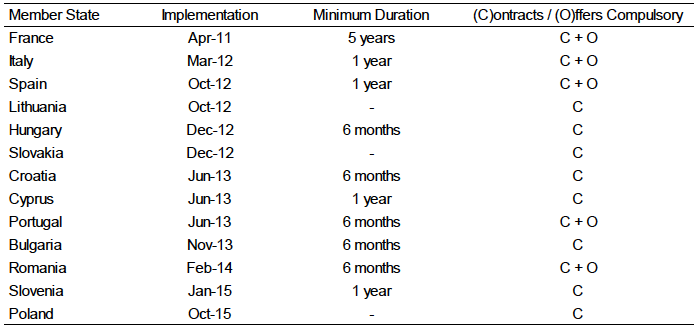
Source: European Commission, 2016.
Agricultural markets volatility and its analysis
7.56 Volatility is a directionless measure of the variability of a price over time (Gilbert and Morgan, 2010). Price movements are a sine qua non requirement embedded in the market’s clearing mechanism that enables demand and supply of any product to match. Price changes may reflect improvements in competitive advantages along the supply chain, as they may also disclose changing preferences on consumers that allow for efficient relocation of resources (O'Connor and Keane, 2011).
7.57 The clearing mechanism usually generates well-stablished smooth price movements that reflect market’s economic core principles. However, unexpected large price variations may occur attending to other multiple factors, accordingly markets that behave in that manner are described as volatile (FAO and OECD, 2011). Impacts caused by excessive market volatility may be varied. Some examples could be among others; inefficient investment induced by risk averse behaviour, non-optimal production decision-making, or food security issues (FAO and OECD, 2011; Piot-Lepetit and M'Bareck, 2011).
7.58 Most agricultural markets possess characteristics that may stimulate volatility. It is common that agricultural markets exhibit price-inelastic demand and supply functions where quantities supplied and demanded vary less than price in proportion. On the other hand, agricultural output may be hugely dependent on weather conditions. As a result of both circumstances small variations in production may prompt huge variations in price (Piot-Lepetit and M'Bareck, 2011). Consequently, observation of price volatility has been highlighted by international organisations and academics as an indispensable input tool for agricultural stakeholders and policymakers alike (FAO and OECD, 2011; Gilbert and Morgan, 2010; Yang, et al., 2001).
7.59 There is abundant economic literature on the analysis of agricultural markets that has focused on the modelling of time-series of commodity prices (Piot-Lepetit and M'Bareck, 2011).
7.60 The classical methodology used by econometricians to analyse time-series consisted in decomposing a series of historical prices into four components; namely: trend, seasonal, cyclical and irregular component (Enders, 2015). The long-run evolution of the series would be explained by the trend component that corresponds with the economic fundamentals of the market showed by the evolution of its price’s mean. Recurrent wavelike price movements are captured by the seasonal and the cyclical components (Enders, 2015; Piot-Lepetit and M'Bareck, 2011).
7.61 The cobweb theorem may be used to illustrate a cyclical movement in the raw milk market generated by a lagged response. According to this theorem, farmers would set their future supply in terms of the price in the current period oversupplying the market in the following period and triggering a fall in prices, subsequently the lag prompted between their decision and the actual demand of milk in the market results in the cycle until the market adjust in the long term (Hansen and Li, 2017). In the same way, seasonal movements may be explained in the dairy sector by the biology of the livestock and the variations of feeding costs and feeding systems throughout the climatic year (Bergmann et al., 2015). Finally, the irregular components or residuals of a time-series are stochastic and usually do not follow a defined pattern in the long-run (Enders, 2015).
7.62 Price movements that follow trend, cyclical or seasonal components are predictable in the long-run, although they may lack interest for analysis in the short-run (Gilbert and Morgan, 2010). Conversely, in spite of the stochastic nature of the irregular component often there exists a positive correlation between the consecutive values of this irregular component in the short-run. As Box et al. observed: “typically, adjacent observations are dependent” (Box, et al., 2016, p. 1). That is, normally a high value in a given period is followed by another high value in the following, as well as low values normally follow low values too. This stylised fact, proper of some time series data has been commonly referred to as volatility clustering (Box, et al., 2016). As a result, the analysis of this irregular component may be of great interest for short-run forecasting, and consequently for the analysis of price volatility (Enders, 2015). This study will focus now on those models that enable to study the evolution of the irregular component of a time-series.
7.63 One of the main assumptions of conventional econometric time-series models is that the variance of the irregular term must be constant. However, the existence of alternating periods of high and low volatility, often seen in some series of economic data, suggests that the assumption of constant variance (homoscedasticity) is not always appropriate (Box, et al., 2016). The Generalized Autoregressive Conditional Heteroscedasticity (GARCH) model developed by Bollerslev (1986) extended the ARCH model introduced by Engle (Engle, 1982). It allows modelling the conditional variance when there exists volatility clustering in the series (Box, et al., 2016).
7.64 In an Autoregressive Moving Average (ARMA) process, the unconditional mean remains constant over time whilst the conditional mean changes as a function of its own lagged values. Similarly, the ARCH model assumes that the unconditional variance of the disturbance process is constant whilst the conditional variance varies as an autoregressive function of past squared errors. Bollerslev generalised the ARCH model, then GARCH, by describing the conditional variance itself as an ARMA process, that is allowing for both autoregressive and moving average components in the heteroskedastic variance formula (Box, Jenkins, Reinsel, and Ljung, 2016; Enders, 2015).
7.65 The GARCH model requires the conditional variance to be positive, imposing non-negativity constraints on the estimated parameters (Kirchgässner, et al., 2013). In addition, the model also imposes stationarity constraints over the process that require the sum of the estimated parameters of the conditional variance to be lesser than 1 (O'Connor and Keane, 2011). If the process is stable the conditional variance in the long-run will tend to equal the unconditional variance, but the model will still capture periods of high and low volatility. When the sum of the parameters exceeds 1, it suggests an explosive series that will deviate from the mean in the long run (Enders, 2015).
Data used in the analysis
7.66 The data consisted of historical time-series of monthly averages prices of raw cow’s milk at real fat content paid to milk producers expressed in euros per 100 kilograms.[11] The data were obtained from the European Commission’s Milk Market Observatory on October 2018 for all those EU members that had implemented in their internal regulation the utilisation of MWCs for the marketing of raw milk (European Commission, 2018). The period covered in this study extends from January 2003 to August 2018, except for Bulgaria and Romania, whose series start at January 2007 and 2009 respectively due to data availability. Croatia was not been included in this analysis due to lack of data before the implementation of MWCs in June 2013.
7.67 The study of price volatility deals with the measurement of its variation over time. Hence, volatility analysis must focus on the second moment or variance of the probability distribution of the data set prices, or any derived transformation from it (Gilbert and Morgan, 2010). Conventionally, volatility studies prefer to use the standard deviation of logarithmic prices as it provides a unit-free comparable measure. In addition, economic price time-series may exhibit trends which may affect price’s volatility beyond the influence of the proper price’s variance process. Measuring volatility as the standard deviation of price returns, that is the standard deviation of changes in logarithmic prices, eliminates this possible influence without imposing unwanted restrictions on the series to eliminate the trend (Gilbert and Morgan, 2010). This study, therefore, used the log returns of monthly average prices of raw milk to asses how the implementation of MWCs has affected prices’ volatility. Table 2 provides descriptive statistics of the series under observation.
7.68 In Table 2, it can be observed that all of the series exhibit the excess kurtosis, with all values larger than 3, that is a typical sign of volatility presence (O'Connor and Keane, 2011).
Table 2: Descriptive statistics
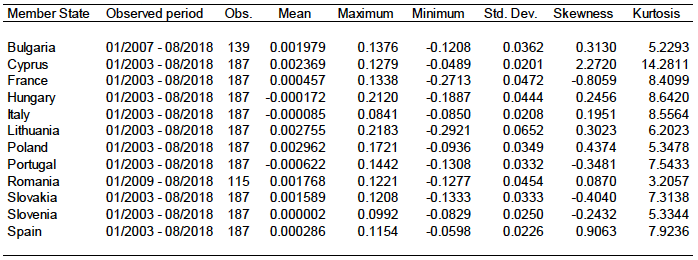
Note: Data are expressed as li returns (Price t /Price t-1) of the average monthly prices of raw milk obtained as €/100kg
7.69 Formal economic time-series models are developed under assumptions laid by probability theory. Since most economic time series data sets occur only once, in order to make statistical inferences from the data, each series is assumed to be just one observed realisation or sample of a stochastic data generating process. Therefore, it is assumed that the sample moments calculated from this data set will converge, when t tends to the infinite, against the moments of the population. However, only if the expected values of these moments remain constant for all t, that is the stochastic process is in statistical equilibrium (stationary), this assumption is meaningful (Kirchgässner, et al., 2013). Consequently, the time-series data sets were checked for stationarity using the Augmented Dickey Fuller (ADF) and the Phillips-Perron (PP) tests (Yang, et al., 2001; Costa-Font and Revoredo-Giha, 2018). Table 3 shows the results from both tests for the log return of the price series. Both tests strongly rejects the null hypothesis of non-stationarity at levels in all the diferentiated series.
Table 3: Non-stationarity tests
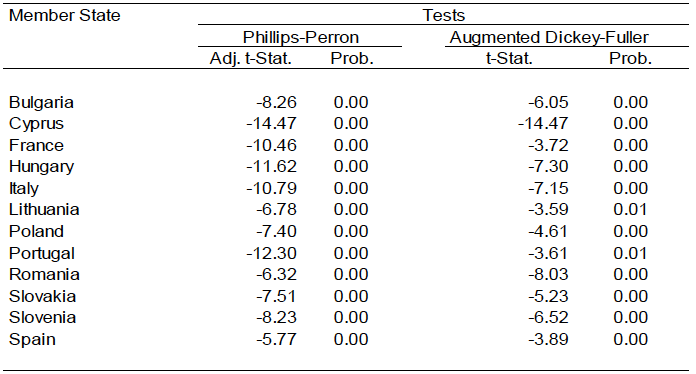
Note: Unit root test of the log-return of the time-series of raw milk prices at levels
Methodology used for the analysis
7.70 Ever since their development GARCH models has been extensively utilised to analyse agricultural commodity markets volatility (Piot-Lepetit and M'Bareck, 2011; O'Connor and Keane, 2011; Gilbert and Morgan, 2010; Yang, et al., 2001). This study uses the GARCH model to test the hypothesis of raw milk price volatility changes in selected European dairy markets associated to the introduction of MWCs as part of the implementation of the EU-CMO regulation.
7.71 The GARCH model allows doing so because it not only describes the time-varying pattern of price variability, but also the model enables the inclusion of explanatory variables in the specification of the conditional variance. Thereby, following Enders (2015) a dummy variable equal to 0 before the introduction of the MWCs and equal to 1 after, was created and added to the model of each country under consideration. The statistical significance of the dummy would indicate whether the introduction of MWCs has affected or not raw milk price volatility, with its positive or negative sign indicating the direction of the change (Yang, et al., 2001). The general form of the ARMA-GARCH model with a dummy variable in the conditional variance formula utilised in this analysis is presented next:

(1) Represents the mean equation of the model, where  is the dependent variable, in this case the log return of raw milk prices;
is the dependent variable, in this case the log return of raw milk prices;  are explanatory lagged values of the dependent variable;
are explanatory lagged values of the dependent variable;  are lagged error terms;
are lagged error terms;  is the error term; and
is the error term; and  are
are  parameters; and p and q are the lag lengths used.
parameters; and p and q are the lag lengths used.
(2) Represents the error component  conditional on the information available
conditional on the information available  at moment t – 1. This error component is assumed to be a white-noise process with a mean equal to zero, a variance ht that follows a Normal distribution, and uncorrelated residuals.
at moment t – 1. This error component is assumed to be a white-noise process with a mean equal to zero, a variance ht that follows a Normal distribution, and uncorrelated residuals.
(3) Finally, shows the structure of the conditional variance equation that accounts for the price volatility in the model; where ht is the time-varying conditional variance of the error term;  are lagged squared residuals; ht–j are lagged values of the conditional variance; Dt is the dummy variable added to detect the MWCs impact;
are lagged squared residuals; ht–j are lagged values of the conditional variance; Dt is the dummy variable added to detect the MWCs impact;  and
and  are parameters; and p and q are the lag lengths for the squared residuals of the error term and the lagged conditional variance.
are parameters; and p and q are the lag lengths for the squared residuals of the error term and the lagged conditional variance.
7.72 The sum of the parameters  will express the degree of volatility clustering in the series. That is, the persistence of the volatility. The closer the sum to 1 the greater the persistence of volatility (O'Connor and Keane, 2011)
will express the degree of volatility clustering in the series. That is, the persistence of the volatility. The closer the sum to 1 the greater the persistence of volatility (O'Connor and Keane, 2011)
Results
7.73 Estimating models were selected following the three-stage Box-Jenkins strategy for univariate time-series (Box, et al., 2016). During the first stage the data were plotted and checked. The histograms show that the marginal distributions of all these series are leptokurtic, tending to have heavier tails than those of a normal distribution. This distributional feature which normally indicates the presence of volatility, is also confirmed by the Jarque-Bera test results which in all cases rejects the null hypothesis of normal distribution. On the other hand, each of the plotted log return values fluctuate around a stable mean level indicating that the time-series are stationary, the dotted line included in each chart indicates the date of MWCs implementation (O'Connor and Keane, 2011).
7.74 According to the Box-Jenkins model selection strategy, it is preliminary to check for the presence of ARCH effects in the residuals of the modelled series. Consistently, an ARMA model was fitted to each of the observed time-series and the residuals were checked for remaining heteroscedasticity using the ARCH Lagrange Multiplier test. The tests for Bulgaria, Cyprus, Italy, Poland, Portugal, and Romania’s time-series did not find remaining heteroscedasticity in the residuals of the fitted ARMA models. In other words, the variance of the log-return of the prices in these series remained constant. These time-series were modelled using an ARIMA model, and in order to assess the influence of the implementation of MWCs over raw milk price variation, a Chow test for structural break in the implementation date of MWCs was carried out on all the homoscedastic series. Table 4, reports ARIMA-model specifications, serial correlation tests of the residuals, and Chow test results. All the models are well specified according to the Ljung-Box Q-statistic test, and the ARCH LM tests could not reject the null of no-ARCH effects on the squared residuals. On the other hand, none of the Chow test could reject either the null hypothesis of no breaks on the date of implementation.
Table 4: ARIMA models and Chow tests
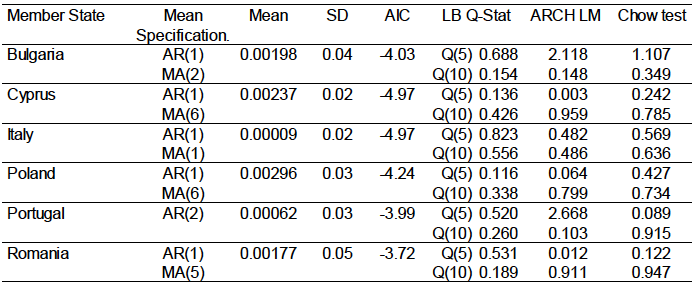
7.75 The rest of the time-series in which ARCH effects on the residuals were detected, namely the series from France, Hungary, Lithuania, Slovakia, Slovenia, and Spain, were subsequently modelled as GARCH processes following the Box-Jenkins approach for the selection of the models. The goal of the second stage of the Box-Jenkins method is to select a parsimonious and stationary model with a good fit. Parsimony entails that the model fits the data well using the minimum number of coefficients.
7.76 The autocorrelation and partial autocorrelation functions were used as guidance for selecting the lags of the AR and MA processes to be included, and models were then selected in terms of their goodness of fit using the Akaike Information Criterion (AIC), and of the stability and non-negativity of the parameters required by the GARCH model (Enders, 2015). Finally, a well specified GARCH model requires the estimated residuals to be uncorrelated and free of ARCH effects (Kirchgässner, et al., 2013). Consistently with that, the standardized residuals were checked for remaining serial correlation on the mean equation using the Ljung-Box Q-statistic test, and any remaining ARCH effect on the residuals of the variance equation was checked using the ARCH Lagrange Multiplier (LM) test and the Ljung-Box test of the squared residuals (Box, Jenkins, Reinsel, and Ljung, 2016; Enders, 2015).
7.77 Table 5 reports GARCH model especifications and test results. Both, the p-values of the ARCH LM tests and the Ljung-Box Q-statistic tests of the squared residuals, show that the null-hypotheses of non-ARCH effect on the residuals of the variance cannot be rejected in any of the models, nor there remain serial correlation on the squared residuals, signalling a good estimation for all the variance equations. Likewise, the Ljung-Box Q-statistic of the residuals rejects any remaining correlation, indicating a good estimation of the mean equation for all the estimated models too.
Table 5: ARCH/GARCH model specifications
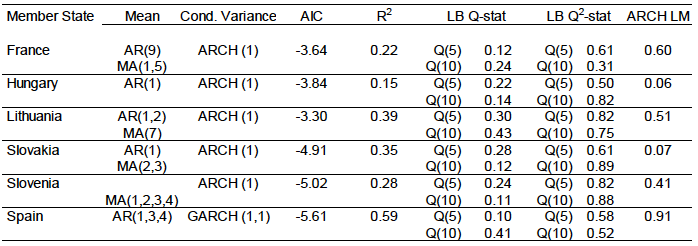
7.78 Finally, table 6 shows the estimated parameters of the conditional variance equations for each time-series. The time-varying variance of the raw milk prices has been confirmed in all the series, since at least one or both of the GARCH parameters  that account for the volatility have been identified as highly statistically significant at the 1% level. The persistence of the volatility clustering effect that is obtained by the addition of both parameters, has been varied ranging from 0.20 (France) to 0.90 (Spain). Of importance in this model is the
that account for the volatility have been identified as highly statistically significant at the 1% level. The persistence of the volatility clustering effect that is obtained by the addition of both parameters, has been varied ranging from 0.20 (France) to 0.90 (Spain). Of importance in this model is the  parameter that signals the impact of the dummy variable that account for the MWCs implementation effect in each country. Five out six of the models (with the exception of the Slovenian model) have identified, as it would be expected according to the EU theoretical presumptions, a negative effect or reduction on price volatility after the implementation of the mandatory contracts. In three of these five time-series, the estimated parameters have been also found significant at the 1% level; namely in the case of France, Hungary, and Slovakia.
parameter that signals the impact of the dummy variable that account for the MWCs implementation effect in each country. Five out six of the models (with the exception of the Slovenian model) have identified, as it would be expected according to the EU theoretical presumptions, a negative effect or reduction on price volatility after the implementation of the mandatory contracts. In three of these five time-series, the estimated parameters have been also found significant at the 1% level; namely in the case of France, Hungary, and Slovakia.
Table 6: Conditional variance equation estimates
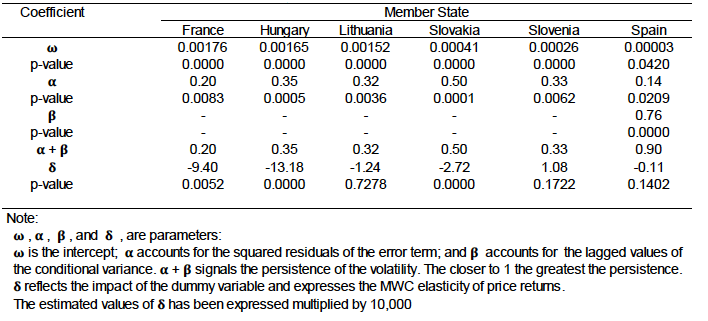
Conclusions
7.79 This study investigated the impact of the implementation of mandatory written contracts (MWC) under the EU agricultural Common Market Organisation (CMO) regulation in raw milk price volatility in twelve member states using GARCH models. The results provide evidence that in three of these Members States (France, Hungary, and Slovakia) milk price volatility decreased after the internal implementation of MWCs.
7.80 However, it should be highlighted that the CMO regulation included not only prescriptions about the introduction of MWC but also other recommendations in order to improve the position of dairy farmers in the supply chain. For instance, dairy farmers’ POs and IBO aimed at improving producers’ bargaining position and transparency within the dairy supply chain. Since all of these measures were available at the same time, it may be controversial to attribute the decreasing volatility effect at the mere introduction of the contracts.
7.81 In the rest of the countries under consideration the results found were varied, with raw milk prices’ variance either found to be constant or to vary in a non-significant manner over the period studied. This could be due to a variety of causes. It is known for instance that written contracts were commonly used within the Italian dairy industry long before the introduction of the CMO regulation, as it could be also the case in other countries.
7.82 In addition, modelling limitations should be also taken under consideration when examining these results. The introduction of a dummy variable indicating the implementation of a new regulation assumes that the effects over the series start from that point onwards, however such effect may take time to materialise and produce the expected effects. Consequently, models may fail to detect the significance in that single point whilst the underlying process is effectively being affected. It is plausible for this reasons that perhaps this effect could be better detected using recursive estimation techniques (Enders, 2015).
7.83 Finally, this study has focused on the analysis of individual country time-series. However, within the EU there exist singular milk buyers that operate in different countries at the same time and the import-export of raw milk is also an extended practice throughout some parts of the EU. Consequently, to undertake a multivariate time-series analysis of raw milk price volatility including a variety of interrelated countries in a single panel data model may be worthy of future investigation.
7.4 Rules set by the Milk Package regarding MWCs
The rules set by the Milk Package (Regulation (EU) No 1308/2013 of the European Parliament and of the Council of 17 December 2013)
Member States can make the use of formal written contracts compulsory. Although, contracts will remain voluntary at EU level. Co-operatives will be exempt from any requirement for compulsory contracts at a member state level.
1. Where a member state decides that every delivery of raw milk between a farmer and processor shall be covered by a written contract, that contract will fulfil the following conditions:
a. The price payable, which will be static and set out in the contract or vary only on factors that are set out in the contract (i.e. a formula or linked to specified market indicators).
b. Volume which may, or shall be delivered and timing of deliveries.
c. Duration of the contract, with termination clauses.
2. A contract will not be required if the farmer supplies a co-op – but only if the co-op statutes contain provisions with the same objective as the Commission’s ‘contract requirements’.
3. The Commission proposes to allow producer organisations to negotiate contract terms, including price jointly, or for some of its members’ production to a dairy:
a. POs will be subject to quantitative limits at EU and member state level.
b. The PO must notify the competent authority of the member state to register as a legal entity.
c. Strict clauses are set out in the regulation that will restrict the activity of the PO so as to prevent price fixing, and other distortions of competition.
4. Member States may also recognise interbranch organisations which:
a. have formally requested recognition and are made up of representatives of economic activities linked to the production of raw milk and linked to at least one of the following stages of the supply chain: processing of or trade in, including distribution of, products of the milk and milk products sector;
b. are formed on the initiative of all or some of the representatives referred to in point ‘a’;
c. carry out, in one or more regions of the Union, taking into account the interests of the members of those interbranch organisations and of consumers.
Contact
Email: socialresearch@gov.scot
There is a problem
Thanks for your feedback